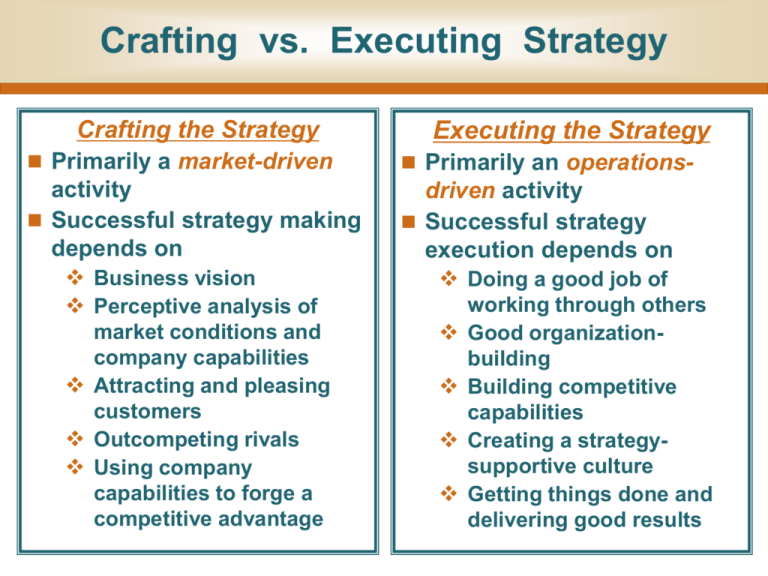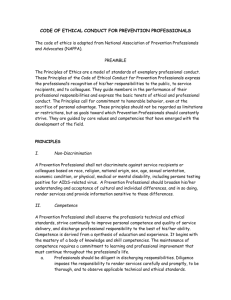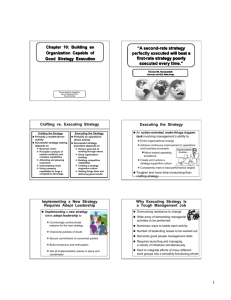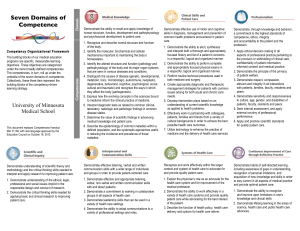culture
advertisement

Crafting vs. Executing Strategy Crafting the Strategy Primarily a market-driven activity Successful strategy making depends on Business vision Perceptive analysis of market conditions and company capabilities Attracting and pleasing customers Outcompeting rivals Using company capabilities to forge a competitive advantage Executing the Strategy Primarily an operations- driven activity Successful strategy execution depends on Doing a good job of working through others Good organizationbuilding Building competitive capabilities Creating a strategysupportive culture Getting things done and delivering good results Implementing a New Strategy Requires Adept Leadership Implementing a new strategy takes adept leadership to Convincingly communicate reasons for the new strategy Overcome pockets of doubt Secure commitment of concerned parties Build consensus and enthusiasm Get all implementation pieces in place and coordinated 1-2 Goals of the Strategy Implementing-Executing Process Unite total organization behind strategy See that activities are done in a manner that is conducive to first-rate strategy execution Generate commitment so an enthusiastic crusade emerges to carry out strategy Fit how organization conducts its operations to strategy requirements 1-3 Figure 10.1: The Eight Components of Strategy Execution Figure 10.2: The Three Components of Building an Organization Capable of Proficient Strategy Execution Building Core Competencies and Competitive Capabilities Crafting the strategy involves Identifying the desired competencies and capabilities to build into the strategy to help achieve a competitive advantage Good strategy execution requires Putting desired competencies and capabilities in place, Upgrading them as needed, and Modifying them as market conditions evolve 1-6 Example: Intel’s Core Competence Design and mass production of complex chips for personal computers Example: Procter & Gamble’s Core Competencies Superb marketing-distribution skills and R&D capabilities in five core technologies - fats, oils, skin chemistry, surfactants, emulsifiers Example: Ciba Specialty Chemicals Core Competence Technology-based competencies allowing it to quickly manufacture products for customers wanting customized products relating to coloration, brightening and whitening, water treatment and paper processing, freshness, and cleaning Example: Disney’s Core Competencies Theme park operation Family entertainment Example: Toyota’s Core Competence Legendary “production system” giving it the capability to produce high-quality vehicles at relatively low costs Three-Stage Process of Developing Competencies and Capabilities 1. First develop ability to do something 2. Build experience and gradually transform the ability into a core competence and proven capability 3. Continue to refine and polish the competence/capability, striving to perform the activity better than rivals, thereby turning the core competence into a distinctive competence and providing a path to competitive advantage! 1-12 Competitive Advantage Potential of Competencies and Capabilities When it is difficult to outstrategize rivals with a superior strategy . . . . . . Best avenue to industry leadership is to out-compete rivals with superior strategy execution! Building competencies and capabilities rivals can’t match is one of the best ways to out-compete them! Figure 10.3: Structuring the Work Effort to Promote Successful Strategy Execution Step 1: Decide Which Value Chain Activities to Perform Internally and Which to Outsource Involves deciding which activities are essential to strategic success Most strategies entail certain crucial business processes or activities that must be performed exceedingly well or in closely coordinated fashion if the strategy is to be executed with real proficiency These processes/activities usually need to be performed internally Other activities, such as routine administrative housekeeping and some support functions, may be candidates for outsourcing Critical activities 1-15 Step 2: Make Strategy-Critical Activities the Main Building Blocks Assign managers of strategy-critical activities a visible, influential position Avoid fragmenting responsibility for strategy-critical activities across many departments Provide coordinating linkages between related work groups Meld into a valuable competitive capability Assign managers key roles Primary activities Strategic relationships Support functions Coordination Valuable capability 1-16 Step 3: Determine How Much Authority to Delegate to Whom In a centralized structure Top managers retain authority for most decisions In a decentralized structure Managers and employees are empowered to make decisions Trend in most companies Shift from authoritarian to decentralized structures stressing empowerment 1-17 Step 4: Provide for Internal Cross-Unit Coordination Classic method of coordinating activities – Have related units report to single manager Upper-level managers have clout to coordinate efforts of their units Support activities should be woven into structure to Maximize performance of primary activities Contain costs of support activities Formal reporting relationships often need to be supplemented to facilitate coordination 1-18 Step 5: Provide for Collaboration With Outsiders Need multiple ties at multiple levels to ensure Communication Coordination and control Find ways to produce collaborative efforts to enhance firm’s capabilities and resource strengths While collaborative relationships present opportunities, nothing valuable is realized until the relationship develops into an engine for better organizational performance 1-19 Characteristics of Organizations of the Future Extensive use of Internet technology and e-commerce business practices Fewer barriers between Change & Different vertical ranks Learning Functions and disciplines Units in different geographic locations Company and its suppliers, distributors, strategic allies, and customers Capacity for change and rapid learning Collaborative efforts among people in different functions and geographic locations Assembling work teams including more members dispersed over a wider geographic area 1-20 MARSHALING RESOURCES BEHIND THE DRIVE FOR GOOD STRATEGY EXECUTION ESTABLISH POLICIES AND PROCEDURES TO FACILITATE STRATEGY EXECUTION ADOPTING BEST PRACTICES AND STRIVING FOR CONTINUOUS IMPROVEMENT What Is Total Quality Management? A philosophy of managing a set of business practices that emphasizes Continuous improvement in all phases of operations 100 percent accuracy in performing activities Involvement and empowerment of employees at all levels Team-based work design Benchmarking and Total customer satisfaction 1-24 Popular TQM Approaches Deming’s 14 Points Crosby’s 14 Quality Steps The Juran Trilogy Baldridge Award Criteria Six Sigma Quality Control — A Tool for Promoting Operating Excellence Six Sigma is a disciplined, statistics-based system aimed at having not more than 3.4 defects per million iterations for any business practice Two approaches to Six Sigma DMAIC process (Design, Measure, Analyze, Improve, Control) An improvement system for existing processes falling below specification and needing incremental improvement A great tool for improving performance when there are wide variations in how well an activity is performed DMADV process (Define, Measure, Analyze, Design, Verify) or DFSS (Design for Six Sigma) An improvement system used to develop new processes or products at Six Sigma quality levels 1-26 Approach of the DMAIC Process Define What constitutes a defect? Measure Collect data to find out why, how, and how often the defect occurs Analyze – Involves Statistical analysis of the metrics Identification of a “best practice” Improve Implementation of the documented “best practice” Control Employees are trained on the “best practice” Over time, significant improvement in quality occurs 1-27 Business Process Reengineering vs. Total Quality Programs Reengineering Aims at quantum gains of 30 to 50% or more Total quality programs Stress incremental progress Techniques are not mutually exclusive Reengineering – Used to produce a good basic design yielding dramatic improvements Total quality programs – Used to perfect process, gradually improving efficiency and effectiveness 1-28 INSTALL INFORMATION AND OPERATING SYSTEMS Examples of Support Systems Airlines On-line reservation system Accurate and expeditious baggage handling system Strict aircraft maintenance program Examples of Support Systems Federal Express Internal communication systems allowing it to coordinate 70,000 vehicles handling an average of 5.5 million packages per day Leading-edge flight operations systems allow a single controller to direct as many as 200 of 650-plus aircraft simultaneously E-business tools for customers Examples of Support Systems Otis Elevator Sophisticated maintenance support system eBay Systems have been developed for real-time monitoring of new listings, bidding activity, Web site traffic, and page views TYING REWARDS AND INCENTIVES TO STRATEGY EXECUTION Gaining Commitment: Components of an Effective Reward System Monetary Incentives Non-Monetary Incentives Base pay increases Praise Performance bonuses Constructive Profit sharing plans Stock options Retirement packages Piecework incentives criticism Special recognition More, or less, job security Stimulating assignments More, or less, autonomy Rapid promotion Examples: Motivational Practices Google Employees are provided with free food, unlimited ice cream, pool and Ping-Pong tables, and complimentary massages. Employees are allowed to spend 20% of their work time on any outside activity. Lincoln Electric Rewards productivity by paying for each piece produced (defects can be traced to worker causing them). Highest rated workers receive bonuses of as much 110% of their piecework compensation. Examples: Motivational Practices JM Family Enterprises Benefits for employees include: a great lease on new Toyotas, cruises in the Bahamas on the 172-foot company yacht, office facility has a heated lap pool, a fitness center, and a free nail salon, and professionally made take-home dinners. Wegmans Employees have flexible schedules and benefits include onsite fitness centers. Employees from cashiers to butchers to store managers are all treated equally and viewed as experts in their jobs. Employees receive 50 hours of formal training per year. Examples: Motivational Practices Ukrop’s Super Markets Stores stay closed on Sunday; company pays out 20% of pretax profits to employees in the form of quarterly bonuses; and the company pays the membership tab for employees if they visit their health club 30 times a quarter. Nordstrom Pay salespeople higher than prevailing rates, plus commission. “Rule #1: Use good judgment in all situations. There will be no additional rules.” Examples: Motivational Practices W. L. Gore Employees get to choose what project/team they work on; each team member’s compensation is based on other team members’ ranking of his/her contribution to the enterprise. Amgen Employees get 16 paid holidays, generous vacation time, tuition reimbursements up to $10,000, on-site massages, a discounted car wash, and the convenience of shopping at on-site farmers’ markets. INSTILLING A STRATEGYSUPPORTIVE CORPORATE CULTURE Defining Characteristics of Corporate Culture Core values, beliefs, and business principles Ethical standards Operating practices and behaviors defining “how we do things around here” Approach to people management “Chemistry” and “personality” permeating work environment Oft-told stories illustrating Company’s values Business practices Traditions 1-40 Features of the Corporate Culture at Wal-Mart Dedication to customer satisfaction Zealous pursuit of low costs Frugal operating practices Strong work ethic Ritualistic Saturday morning meetings Executive commitment to Visit stores Listen to customers Solicit employees’ suggestions 1-41 Features of the Corporate Culture at General Electric Hard-driving, results-oriented atmosphere prevails All businesses are held to a standard of being #1 or #2 in their industries as well as achieving good business results Extensive cross-business sharing of ideas, best practices, and learning Reliance on “workout sessions” to identify, debate, and resolve “burning issues” Commitment to Six Sigma Quality Globalization of the company 1-42 Features of the Corporate Culture at Nordstrom’s Deliver exceptional customer service to customers Company motto “Respond to Unreasonable Customer Requests” Out-of-the-ordinary customer requests viewed as opportunities for “heroic” acts 1-43 Where Does Corporate Culture Come From? Founder or early leader Influential individual or work group Policies, vision, or strategies Operating approaches Company’s approach to people management Traditions, supervisory practices, employee attitudes Organizational politics Relationships with stakeholders 1-44 Forces Causing Culture to Evolve New challenges in marketplace Revolutionary technologies Shifting internal conditions Internal crisis Turnover of top executives A new CEO who opts to change things Diversification into new businesses Expansion into foreign countries Rapid growth that involves adding many new employees Merger with or acquisition of another company 1-45 Types of Corporate Cultures Strong vs. Weak Cultures Unhealthy Cultures High-Performance Cultures Adaptive Cultures Hallmarks of Adaptive Cultures Willingness to accept change and embrace challenge of introducing new strategies Risk-taking, experimentation, and innovation to satisfy stakeholders Entrepreneurship is encouraged and rewarded Funds provided for new products New ideas openly evaluated Genuine interest in well-being of all key constituencies Proactive approaches to implement workable solutions 1-47 Culture: Ally or Obstacle to Strategy Execution? A company’s culture can contribute to – or hinder – successful strategy execution A culture that promotes attitudes and behaviors that are well-suited to first-rate strategy execution is a valuable ally in the strategy execution process A culture where attitudes and behaviors impede good strategy execution is a huge obstacle to be overcome 1-48 Figure 12.1: Changing a Problem Culture Symbolic Culture-Changing Actions Lead by example – Walk the talk Emphasize frugality Eliminate executive perks Require executives to spend time talking with customers Ceremonial events to praise people and teams who “get with the program” Alter practices identified as cultural hindrances Visible awards to honor heroes 1-50 Grounding the Culture in Core Values and Ethics A culture based on ethical principles is vital to long-term strategic success Ethics programs help make ethical conduct a way of life Executives must provide genuine support of personnel displaying ethical standards in conducting the company’s business Value statements serve as a cornerstone for culture-building 1-51 Approaches to Establishing Ethical Standards Formal values statement and a code of ethics Word-of-mouth indoctrination and tradition Annual reports and Websites Making stakeholders aware of a commitment to ethical business conduct is attributable to Greater management understanding of role these statements play in culture building Renewed focus on ethical standards stemming from recent corporate scandals Growing numbers of consumers who prefer to patronize ethical companies 1-52 Figure 12.2: The Two Culture-Building Roles of a Company’s Core Values and Ethical Standards Establishing a Strategy-Culture Fit in Multinational and Global Companies Institute training programs to Communicate the meaning of core values and Explain the case for common operating principles and practices Create a cultural climate where the norm is to Adopt best practices Use common work procedures Pursue operating excellence Give local managers Flexibility to modify people management approaches or operating styles Discretion to use different motivational and compensation incentives to induce personnel to practice desired behaviors 1-54 Leading the Strategy-Execution Process







